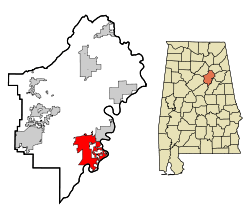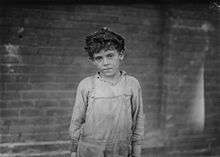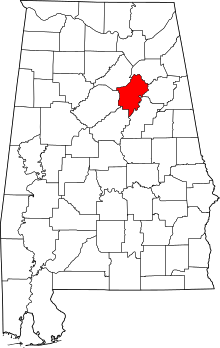Pell City, Alabama
| Pell City, Alabama | |
|---|---|
| City | |
 Location in St. Clair County and the state of Alabama | |
| Coordinates: 33°34′15″N 86°16′26″W / 33.57083°N 86.27389°W | |
| Country | United States |
| State | Alabama |
| County | St. Clair |
| Area | |
| • Total | 27.2 sq mi (70.3 km2) |
| • Land | 24.6 sq mi (63.6 km2) |
| • Water | 2.6 sq mi (6.7 km2) |
| Elevation | 597 ft (182 m) |
| Population (2010) | |
| • Total | 12,463 |
| • Density | 458.2/sq mi (177.3/km2) |
| Time zone | Central (CST) (UTC-6) |
| • Summer (DST) | CDT (UTC-5) |
| ZIP codes | 35125, 35128, 35054 |
| Area code(s) | 205 |
| FIPS code | 01-58896 |
| GNIS feature ID | 0164801 |
| Website | http://pell-city.com/ |
Pell City is a city in St. Clair County, Alabama, United States. The city is the county seat of St. Clair County[1] along with Ashville. At the 2000 census the population was 9,565. At the 2010 census, the city-limit population jumped to 12,695.[2]
Geography
According to the U.S. Census Bureau, the city has a total area of 27.2 square miles [sq mi] (70 km2), of which 24.6 sq mi (64 km2) is land and 2.6 sq mi (6.7 km2) or 9.57% is water. Pell City, situated on Interstate 20 between Birmingham, Alabama and Atlanta, Georgia is the largest city in St. Clair County. The city is 35 miles east of Birmingham and is located on the shores of Logan Martin Lake, created by the construction of Logan Martin Dam in 1964 to provide hydro-electric power to the central region of the state. The city is surrounded by the unincorporated communities of Wattsville to the north, Cropwell to the south, Seddon to the east, and Chula Vista to the west.
Demographics
| Historical population | |||
|---|---|---|---|
| Census | Pop. | %± | |
| 1900 | 98 | — | |
| 1910 | 530 | 440.8% | |
| 1920 | 825 | 55.7% | |
| 1930 | 835 | 1.2% | |
| 1940 | 900 | 7.8% | |
| 1950 | 1,189 | 32.1% | |
| 1960 | 4,165 | 250.3% | |
| 1970 | 5,602 | 34.5% | |
| 1980 | 6,616 | 18.1% | |
| 1990 | 8,118 | 22.7% | |
| 2000 | 9,565 | 17.8% | |
| 2010 | 12,695 | 32.7% | |
| Est. 2015 | 13,646 | [3] | 7.5% |
| U.S. Decennial Census[4] 2013 Estimate[5] | |||
As of the census[6] of 2000, there were 9,565 people, 3,830 households, and 2,772 families residing in the city. The population density was 389.3 people per square mile (150.3/km²). There were 4,275 housing units at an average density of 174.0 per square mile (67.2/km²). The population of the city is hard to pinpoint due to a large number of second residences, lake homes, and summer population influx. The racial makeup of the city was 83.41% White, 15.38% Black or African American, 0.16% Native American, 0.22% Asian, 0.02% Pacific Islander, 0.26% from other races, and 0.55% from two or more races. 1.25% of the population were Hispanic or Latino of any race.
There were 3,830 households out of which 30.3% had children under the age of 18 living with them, 56.9% were married couples living together, 12.1% had a female householder with no husband present, and 27.6% were non-families. 24.5% of all households were made up of individuals and 10.9% had someone living alone who was 65 years of age or older. The average household size was 2.47 and the average family size was 2.92. 76.3% of residents were high school graduates or higher, and 17.1% held a bachelor's degree or higher.
In the city the population was spread out with 23.9% under the age of 18, 7.5% from 18 to 24, 27.6% from 25 to 44, 25.0% from 45 to 64, and 16.0% who were 65 years of age or older. The median age was 39 years. For every 100 females there were 90.6 males. For every 100 females age 18 and over, there were 87.8 males.
The median household income in the city was $48,300. About 7.5% of families and 11.2% of the population were below the poverty line, including 15.2% of those under age 18 and 9.8% of those age 65 or over. However, these figures provide an incomplete picture of the area. Many of the affluent neighborhoods along the lake shore that are often considered part of Pell City are actually just outside the city limits in unincorporated areas. These neighborhoods constitute a sizable population and income level, but are not reflected in official city census data.
2010 census
As of the census[7] of 2010, there were 12,463 people, 5,149 households, and 3,545 families residing in the city. The population density was 458.2 people per square mile (177.3/km²). There were 5,784 housing units at an average density of 212.6 per square mile (82.3/km²). The racial makeup of the city was 80.8% White, 15.6% Black or African American, 0.3% Native American, 0.8% Asian, 0.1% Pacific Islander, 1.1% from other races, and 1.4% from two or more races. 2.3% of the population were Hispanic or Latino of any race.
There were 3,830 households out of which 29.0% had children under the age of 18 living with them, 49.9% were married couples living together, 14.6% had a female householder with no husband present, and 31.2% were non-families. 27.3% of all households were made up of individuals and 10.4% had someone living alone who was 65 years of age or older. The average household size was 2.42 and the average family size was 2.92.
In the city the population was spread out with 23.7% under the age of 18, 7.9% from 18 to 24, 26.0% from 25 to 44, 26.7% from 45 to 64, and 15.7% who were 65 years of age or older. The median age was 39 years. For every 100 females there were 89.1 males. For every 100 females age 18 and over, there were 90.5 males.
The median household income in the city was $43,260. About 10.5% of families and 10.7% of the population were below the poverty line, including 14.6% of those under age 18 and 9.4% of those age 65 or over.
History

Pell City was founded in 1890 by railroad investors and named after Jonathan H. Pell of the Pell City Iron and Land Company, one of its financial backers. The city was incorporated on May 6, 1891, but nearly failed during the Panic of 1893. However, it was revived in 1902 when Sumter Cogswell built the Pell City Manufacturing Company, which subsequently became Avondale Mills, a major landmark of the town until Thunder Enterprises, a Tennessee company, bought the building and began dismantling the factory in 2008. The mill was the economic and social center of the town during its development and early growth. Besides the textile mill, other economic endeavors included agriculture and mercantile establishments. Large cotton, soybean, and cattle farms were located in the area. Pell City increased its size in 1956 when the nearby towns of Eden and Oak Ridge were merged with the city. The first mayor was Green Evans.
The residences of Sumter Cogswell and Green Evans (Pell City’s first mayor) are two of the earliest structures, dating from the late nineteenth century. The majority of the historic structures date from 1902 to 1905.
Ashville, Alabama in the northern part of the St. Clair County, was the only county seat from 1821 to 1907. A constitutional amendment in 1907 established Pell City as the second county seat. For many years, St. Clair County was the only county in the country with two full-service county seats. Both county seats remain operational to this day although Pell City has far outstripped Ashville in growth thanks in no small part to the convergence of both I-20 and Logan Martin Lake. The construction of the Logan Martin Dam in 1964 changed the geography of the town by creating a large lake. This also created a large recreational area which brought new businesses, temporary summer residents and tourists and hundreds of new permanent residents building new homes along the new lake.
On April 8, 1998, an F2 tornado struck north of the city limits after the F5 tornado expired in western Jefferson County. This windstorm killed two people in a mobile home. It remained for 14 miles (22 km), partially damaging a church, twenty-six homes and mobile homes, and other buildings in Coal City. Ninety other homes and mobile homes suffered minor to major destruction. An additional twelve people were injured. The twister damaged a funeral home and twenty-five homes. The Bethel Baptist Church in Odenville was destroyed a few minutes after its members left an Easter pageant rehearsal that had been cancelled because of the storm.
Schools
After a period of growth in the 1980s, Pell City voted to split its school system off from the county system, becoming independent. The system has over 4500 students spread across Pell City High School, Duran Junior High School, Duran South, Iola Roberts Elementary, Walter M. Kennedy Elementary, Coosa Valley Elementary, Eden Elementary, and Elouise and Harold Williams Intermediate School. The system also operates a Trade School as an alternative to college prep courses.
In 2005 Jefferson State Community College opened a new campus location in Pell City offering a wide variety of community college courses. The school announced in 2009 that it will begin offering nursing programs to support the recently confirmed Veterans Nursing Home and St. Vincent's St. Clair Hospital.
Development
In the mid-2000s, Pell City experienced a period of rapid residential and commercial growth (estimated population around 16,000, excluding the unincorporated residential areas just south of the city along the lakefront) spurred, partly, by the opening of the Honda Plant in nearby Lincoln, Alabama, a new industrial park on its northeastern border, and by a new retail area on the north side of I-20 anchored by a Wal-Mart, Home Depot, and several fast food and casual dining restaurants.
The city is the home of a recently built veteran's nursing home and hospital serving the entire county. The veterans home is a 280-bed facility built in a neighborhood style of several small cottage clusters, instead of one large institution. The new hospital, operated by the St. Vincents Health System, will serve the entire county, but be located within the city limits. It replaces the aging St. Vincents East formally known as St. Clair Regional.
In August 2011, two of the city's schools (Iola Roberts Elementary and Pell City High School) started school after undergoing renovations and/or expansions to their campuses.
Commercial development once again seems to be coming back to Pell City. A Publix Supermarket, small shopping center, and restaurants have opened on the south end of Pell City. It is thought these developments will spur growth on an end of town that has a sizable, affluent population (both in and outside the city near the lake) but has been underserved by commercial development.
Media
Pell City, and all of St. Clair County, is located in Birmingham's designated market area for local news and weather coverage. The city has one dedicated FM radio station, WFHK.
Pell City is served by two daily and two weekly newspapers. The Birmingham News serves the county, and The Daily Home, which also represents Talladega County, maintains an office in the city. The weekly St. Clair News-Aegis and St Clair Times offer more local coverage. The latter is an offshoot of The Daily Home.
Notable people
- David Gulledge, former NFL player
- Lum Harris, former Major League Baseball pitcher, coach, and manager
- Todd Jones, former pitcher for the Detroit Tigers
- Jeanne Pruett, country music singer, best known for her song "Satin Sheets"
References
- ↑ "Find a County". National Association of Counties. Retrieved 2011-06-07.
- ↑ http://www.dailyhome.com/view/full_story/14374229/article-Population-growth-means-city-must-change-its-form-of-government?instance=home_news_right
- ↑ "Annual Estimates of the Resident Population for Incorporated Places: April 1, 2010 to July 1, 2015". Retrieved July 2, 2016.
- ↑ "U.S. Decennial Census". Census.gov. Retrieved June 6, 2013.
- ↑ "Annual Estimates of the Resident Population: April 1, 2010 to July 1, 2013". Retrieved June 3, 2014.
- ↑ "American FactFinder". United States Census Bureau. Retrieved 2008-01-31.
- ↑ "American FactFinder". United States Census Bureau. Retrieved 2015-08-09.
External links
Coordinates: 33°34′15″N 86°16′26″W / 33.570907°N 86.273845°W
